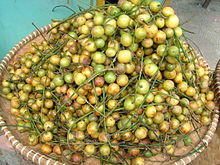Baccaurea
| Baccaurea | |
|---|---|

| |
| Fruits of Baccaurea racemosa | |
| Scientific classification | |
| Kingdom: | Plantae |
| Clade: | Tracheophytes |
| Clade: | Angiosperms |
| Clade: | Eudicots |
| Clade: | Rosids |
| Order: | Malpighiales |
| Family: | Phyllanthaceae |
| Subfamily: | Antidesmatoideae |
| Tribe: | Scepeae |
| Genus: | Baccaurea Lour. (1790) |
| Type species | |
| Baccaurea ramiflora[1] | |
| Species | |
|
See text | |
| Synonyms[2] | |
Baccaurea[1] is a genus of flowering plants belonging to the family Phyllanthaceae. The genus comprises 51 species, distributed from India to Indochina, southern China, Malesia, New Guinea, and the West Pacific.[2] It is dioecious, with male and female flowers on separate plants.[3] Many species contain edible fruits.[4]


Species[edit]
51 species are accepted.[2]
- Baccaurea airyshawii Chakrab. & M.Gangop.
- Baccaurea angulata Merr.
- Baccaurea annamensis Gagnep.
- Baccaurea bakeri Elmer ex Merr.
- Baccaurea bracteata Müll.Arg.
- Baccaurea brevipes Hook.f.
- Baccaurea carinata Haegens
- Baccaurea celebica Pax & K.Hoffm.
- Baccaurea costulata (Miq.) Müll.Arg.
- Baccaurea courtallensis (Wight) Müll.Arg.
- Baccaurea dasystachya (Miq.) Müll.Arg.
- Baccaurea deflexa Müll.Arg.
- Baccaurea dolichobotrys Merr.
- Baccaurea dulcis (Jack) Müll.Arg.
- Baccaurea edulis Merr.
- Baccaurea henii Thìn
- Baccaurea javanica (Blume) Müll.Arg.
- Baccaurea lanceolata (Miq.) Müll.Arg.
- Baccaurea macrocarpa (Miq.) Müll.Arg.
- Baccaurea macrophylla (Müll.Arg.) Müll.Arg.
- Baccaurea maingayi Hook.f.
- Baccaurea malayana King ex Hook.f.
- Baccaurea microcarpa (Airy Shaw) Haegens
- Baccaurea minor Hook.f.
- Baccaurea mollis Haegens
- Baccaurea motleyana (Müll.Arg.) Müll.Arg.
- Baccaurea multiflora Burck ex J.J.Sm.
- Baccaurea nanihua Merr.
- Baccaurea nesophila Airy Shaw
- Baccaurea odoratissima Elmer
- Baccaurea papuana F.M.Bailey
- Baccaurea parviflora (Müll.Arg.) Müll.Arg.
- Baccaurea philippinensis (Merr.) Merr.
- Baccaurea polyneura Hook.f. (syn. Baccaurea hookeri Gage)
- Baccaurea ptychopyxis Airy Shaw
- Baccaurea pubera (Miq.) Müll.Arg. (syn. Baccaurea latifolia King ex Hook.f.)
- Baccaurea purpurea Haegens
- Baccaurea pyriformis Gage
- Baccaurea racemosa (Reinw.) Müll.Arg.
- Baccaurea ramiflora Lour.
- Baccaurea reniformis Chakrab. & M.Gangop.
- Baccaurea reticulata Hook.f.
- Baccaurea sarawakensis Pax & K.Hoffm.
- Baccaurea seemannii (Müll.Arg.) Müll.Arg.
- Baccaurea simaloerensis Haegens
- Baccaurea sumatrana (Miq.) Müll.Arg.
- Baccaurea sylvestris Lour.
- Baccaurea taitensis Müll.Arg.
- Baccaurea tetrandra (Baill.) Müll.Arg.
- Baccaurea trigonocarpa Merr.
- Baccaurea velutina (Ridl.) Ridl.
References[edit]
- ^ a b Flora Cochinchinensis 2: 661. 1790. "Name - Baccaurea Lour". Tropicos. Saint Louis, Missouri: Missouri Botanical Garden. Retrieved February 6, 2010.
Type Specimen: Baccaurea ramiflora Lour.
- ^ a b c Baccaurea Lour. Plants of the World Online. Retrieved 17 March 2024.
- ^ Hoffmann, Petra; Kathriarachchi, Hashendra; Wurdack, Kenneth J. (2006). "A Phylogenetic Classification of Phyllanthaceae (Malpighiales; Euphorbiaceae sensu lato)". Kew Bulletin. 61 (1): 37–53. JSTOR 20443245.
- ^ "Baccaurea (PROSEA Fruits) - PlantUse English". uses.plantnet-project.org. Retrieved 15 September 2021.
